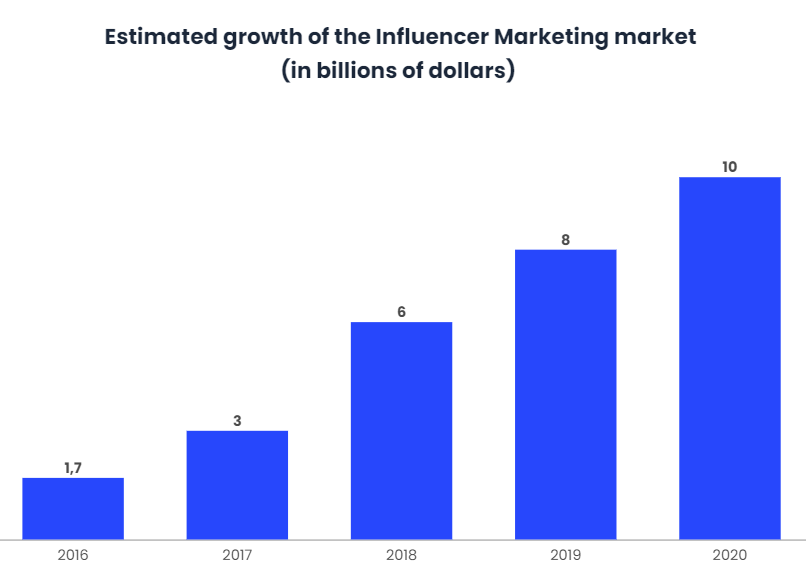Does Influencer Marketing really work?

Over the past two decades, social media has become an integral part of people’s lives, and a crucial way for brands to reach new audiences. As more users have been joining social networking platforms such as Facebook, Youtube, Instagram, Pinterest, Snapchat and Twitter, many have become content creators, curating and crafting their own stories, photos and videos for others to see. And that’s how social media influencers were born, and quickly attracted the attention of marketers.
In the last five years, many brands have collaborated with social media influencers through awareness channels. This is called ‘influencer marketing’, which basically describes a marketing approach in which a person’s awareness is used to bring more attention to a product or brand. Brands leverage the existing relationships that influencers have with their followers in exchange for a fee for their support, which is shared in their network along with their non-sponsored content.
This type of marketing is suitable for almost all types of companies, it may seem that influencing marketing is more frequent in consumer brands focused on millennials, but that is not the case. Many B2B organisations are developing influencer marketing programmes with subject matter experts that can help shorten their sales cycles and lead to higher closing rates.
As long as a company has a quality product or service that customers want, a captive and engaged audience, and a process for tracking, managing and paying influencers, this marketing strategy will work.
A market that doesn’t stop growing
The “boom” of influencers and the great potential they have for brands has caused this powerful marketing asset to become a major part of companies’ strategies. In fact, 84% of executives, globally, believe that influencer marketing is effective in connecting with consumers in social networks, and 90% of them plan to maintain or increase their budget in influencing marketing.
Influence marketing is gaining more traction and investment than ever before, with the industry estimated to be worth $1.7 billion by 2016. Since then it has grown rapidly every year. In 2019 the industry had a turnover of $8 billion, almost $2 billion more than the previous year. And by 2020, the global growth rate will be around 125%, which will allow the industry to break the $10 billion worldwide turnover barrier.

In Spain, for this year, investment in this sector is expected to be 170 million euros, compared to 100 million in 2019, 35 million in 2018 and 8 million in 2017.
Why bet on influencer marketing?
Unlike other digital marketing strategies, influencer marketing offers a number of advantages that are worth knowing:
- Influencers have the attention of the public, especially millennials and Generation Z. They have followers who trust them and are interested in everything they do and consume.
- They help to position a brand in the market and in the consumer’s mind.
- They generate positive content of great value on a product or service that lasts over time.
- They help to improve the SEO positioning of a website.
- They are consumer prescribers. They boost sales of a product directly.
- It is possible to reach a large percentage of the target audience of a campaign more efficiently than with other media.
- Well managed, an influencer marketing campaign can achieve a profitable return on investment (ROI).
- The brand gains reputation and prestige.
Main objectives of influencer marketing
Before a company embarks on an influencer marketing campaign, it is important to be clear about its objectives. In general, key performance indicators (KPIs) for brands are divided into two fields:
- Brand awareness: metrics linked to increased audience awareness of your product or service, such as impressions of content, likes, comments, mentions, reach and traffic.
- Direct Response: metrics linked to specific actions, such as clicks, sales, conversions, leads, downloads and subscribers.
Some influencer marketing campaigns are divided into both fields, which drives engagement and some form of conversion. The main objectives of influencer marketing are:
- Increase brand awareness: create awareness of a brand, product or service.
- Reach new audiences: influencers must be able to share their audience data (age, gender, location, interests, etc.) to help ensure alignment with their target audience.
- Generate sales.
- Improve brand promotion: generate word of mouth conversations about the product or brand among your supporters.
- Drive lead generation: in addition to sales, new leads are another popular direct response measure for influencer marketing campaigns. Names and emails can be collected through newsletter subscriptions, account settings or gift tickets.
On the other hand, many factors can negatively affect the performance of an influencer marketing campaign. Here are a few:
- Select influencers that are not aligned with the brand, or that would not normally use the product.
- Do not evaluate the alignment of the influencer’s target audience before partnering.
- Discover that the influencer has false followers.
- Forcing a rigid script on the influencer, rather than collaborating on a creative approach to make it resonate with its followers
- Not setting clear terms and deadlines for their agreement.
- Publishing blatantly promotional and hard sell content that turns off followers.
- Not setting up proper tracking, URLs, or landing pages beforehand
The fact is that although these factors can appear, when executed correctly, influencer marketing works for a wide range of companies, and the data supports it.
Conclusions
Increasingly, the implementation of these kinds of strategies is more present in media plans and marketing plans. As we move into 2020, influencer marketing shows no signs of slowing down, and studies show that many companies and brands spend a large part of their budget on influencer marketing and that, as the years go by, that budget is increasing. Some of the keys to this trend are:
- Marketers consider influencer marketing to be effective and are increasing their budgets in 2020.
- Whether the goal is to increase brand awareness, sales or reach new audiences, clear KPIs (and tracking) must always be established in advance.
- Instagram is the king of influencer marketing.
- You have to take the time to find the right influencers.
- Watch out for signs of false influencers or that the engagement is not genuine, as the signs suggest that this problem will not go away.
This is a sector in clear growth, immersed in a current process of process automation through technology, so we can say that influence marketing is one of the most effective digital marketing strategies to impact the target audience in a non-abusive, integrated and with a favorable return on investment. As long as, a defined strategy is established according to the objectives.


